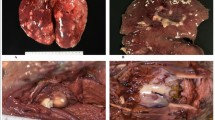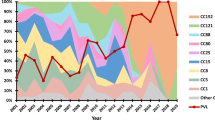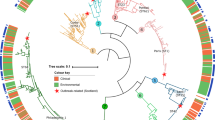Abstract
The staphylococcal bi-component leukocidins Panton–Valentine leukocidin (PVL) and γ-haemolysin CB (HlgCB) target human phagocytes. Binding of the toxins’ S-components to human complement C5a receptor 1 (C5aR1) contributes to cellular tropism and human specificity of PVL and HlgCB. To investigate the role of both leukocidins during infection, we developed a human C5aR1 knock-in (hC5aR1KI) mouse model. HlgCB, but unexpectedly not PVL, contributed to increased bacterial loads in tissues of hC5aR1KI mice. Compared to humans, murine hC5aR1KI neutrophils showed a reduced sensitivity to PVL, which was mediated by the toxin’s F-component LukF-PV. By performing a genome-wide CRISPR–Cas9 screen, we identified CD45 as a receptor for LukF-PV. The human-specific interaction between LukF-PV and CD45 provides a molecular explanation for resistance of hC5aR1KI mouse neutrophils to PVL and probably contributes to the lack of a PVL-mediated phenotype during infection in these mice. This study demonstrates an unsuspected role of the F-component in driving the sensitivity of human phagocytes to PVL.
This is a preview of subscription content, access via your institution
Access options
Access Nature and 54 other Nature Portfolio journals
Get Nature+, our best-value online-access subscription
$32.99 / 30 days
cancel any time
Subscribe to this journal
Receive 12 digital issues and online access to articles
$119.00 per year
only $9.92 per issue
Buy this article
- Purchase on SpringerLink
- Instant access to full article PDF
Prices may be subject to local taxes which are calculated during checkout





Similar content being viewed by others
Change history
03 September 2018
In the version of this Article originally published, the name of author Robert Jan Lebbink was coded wrongly, resulting in it being incorrect when exported to citation databases. This has now been corrected, though no visible changes will be apparent.
References
Thwaites, G. E. et al. Clinical management of Staphylococcus aureus bacteraemia. Lancet Infect. Dis. 11, 208–222 (2011).
Deleo, F. R., Otto, M., Kreiswirth, B. N. & Chambers, H. F. Community-associated meticillin-resistant Staphylococcus aureus. Lancet 375, 1557–1568 (2010).
Fowler, V. G. et al. Effect of an investigational vaccine for preventing Staphylococcus aureus infections after cardiothoracic surgery: a randomized trial. JAMA 309, 1368–1378 (2013).
Spaan, A. N., Surewaard, B. G., Nijland, R. & van Strijp, J. A. Neutrophils versus Staphylococcus aureus: a biological tug of war. Annu. Rev. Microbiol. 67, 629–650 (2013).
Alonzo, F. III. & Torres, V. J. The bicomponent pore-forming leucocidins of Staphylococcus aureus. Microbiol. Mol. Biol. Rev. 78, 199–230 (2014).
Vandenesch, F., Lina, G. & Henry, T. Staphylococcus aureus hemolysins, bi-component leukocidins, and cytolytic peptides: a redundant arsenal of membrane-damaging virulence factors? Front. Cell Infect. Microbiol. 2, 12 (2012).
Spaan, A. N., van Strijp, J. A. G. & Torres, V. J. Leukocidins: staphylococcal bi-component pore-forming toxins find their receptors. Nat. Rev. Microbiol. 15, 435–447 2017).
Peraro, M. D. & van der Goot, F. G. Pore-forming toxins: ancient, but never really out of fashion. Nat. Rev. Microbiol. 14, 77–92 (2016).
Ferreras, M. et al. The interaction of Staphylococcus aureus bi-component γ-hemolysins and leucocidins with cells and lipid membranes. Biochim. Biophys. Acta 1414, 108–126 (1998).
Dalla Serra, M. et al. Staphylococcus aureus bicomponent γ-hemolysins, HlgA, HlgB, and HlgC, can form mixed pores containing all components. J. Chem. Inf. Model. 45, 1539–1545 (2005).
Konig, B., Prevost, G. & Konig, W. Composition of staphylococcal bi-component toxins determines pathophysiological reactions. J. Med. Microbiol. 46, 479–485 (1997).
Yoong, P. & Torres, V. J. Counter inhibition between leukotoxins attenuates Staphylococcus aureus virulence. Nat. Commun. 6, 8125 (2015).
DuMont, A. L. et al. Staphylococcus aureus LukAB cytotoxin kills human neutrophils by targeting the CD11b subunit of the integrin Mac-1. Proc. Natl Acad. Sci. USA 110, 10794–10799 (2013).
Spaan, A. N. et al. The staphylococcal toxin Panton–Valentine leukocidin targets human C5a receptors. Cell Host Microbe 13, 584–594 2013).
Reyes-Robles, T. et al. Staphylococcus aureus leukotoxin ED targets the chemokine receptors CXCR1 and CXCR2 to kill leukocytes and promote infection. Cell Host Microbe 14, 453–459 (2013).
Spaan, A. N. et al. The staphylococcal toxins γ-haemolysin AB and CB differentially target phagocytes by employing specific chemokine receptors. Nat. Commun. 5, 5438 (2014).
Koop, G. et al. Identification of LukPQ, a novel, equid-adapted leukocidin of Staphylococcus aureus. Sci. Rep. 7, 40660 (2017).
Spaan, A. N. et al. Staphylococcus aureus targets the Duffy antigen receptor for chemokines (DARC) to lyse erythrocytes. Cell Host Microbe 18, 363–370 2015).
Vrieling, M. et al. Bovine Staphylococcus aureus secretes the leukocidin LukMF’ to kill migrating neutrophils through CCR1. mBio 6, e00335 (2015).
Alonzo, F. III. et al. CCR5 is a receptor for Staphylococcus aureus leukotoxin ED. Nature 493, 51–55 (2013).
Spaan, A. N. et al. Differential interaction of the staphylococcal toxins Panton–Valentine leukocidin and γ-hemolysin CB with human C5a receptors. J. Immunol. 195, 1034–1043 (2015).
Tawk, M. Y. et al. Internalization of staphylococcal leukotoxins that bind and divert the C5a receptor is required for intracellular Ca2+ mobilization by human neutrophils. Cell. Microbiol. 17, 1241–1257 (2015).
Labandeira-Rey, M. et al. Staphylococcus aureus Panton–Valentine leukocidin causes necrotizing pneumonia. Science 315, 1130–1133 (2007).
Bubeck Wardenburg, J., Bae, T., Otto, M., Deleo, F. R. & Schneewind, O. Poring over pores: α-hemolysin and Panton–Valentine leukocidin in Staphylococcus aureus pneumonia. Nat. Med. 13, 1405–1406 (2007).
Diep, B. A. et al. Polymorphonuclear leukocytes mediate Staphylococcus aureus Panton–Valentine leukocidin-induced lung inflammation and injury. Proc. Natl Acad. Sci. USA 107, 5587–5592 (2010).
Cremieux, A. C. et al. Panton–Valentine leukocidin enhances the severity of community-associated methicillin-resistant Staphylococcus aureus rabbit osteomyelitis. PLoS ONE 4, e7204 (2009).
Diep, B. A. et al. Contribution of Panton–Valentine leukocidin in community-associated methicillin-resistant Staphylococcus aureus pathogenesis. PLoS ONE 3, e3198 (2008).
Lipinska, U. et al. Panton–Valentine leukocidin does play a role in the early stage of Staphylococcus aureus skin infections: a rabbit model. PLoS ONE 6, e22864 (2011).
Kobayashi, S. D. et al. Comparative analysis of USA300 virulence determinants in a rabbit model of skin and soft tissue infection. J. Infect. Dis. 204, 937–941 (2011).
Shallcross, L. J., Fragaszy, E., Johnson, A. M., & Hayward, A. C. The role of the Panton-Valentine leucocidin toxin in staphylococcal disease: a systematic review and meta-analysis. Lancet Infect. Dis. 13, 43–54 (2013).
Tseng, C. W. et al. Increased susceptibility of humanized NSG mice to Panton–Valentine leukocidin and Staphylococcus aureus skin infection. PLoS Pathog. 11, e1005292 (2015).
Prince, A., Wang, H., Kitur, K. & Parker, D. Humanized mice exhibit increased susceptibility to Staphylococcus aureus pneumonia. J. Infect. Dis. 215, 1386–1395 (2017).
Monk, P. N., Scola, A. M., Madala, P. & Fairlie, D. P. Function, structure and therapeutic potential of complement C5a receptors. Br. J. Pharmacol. 152, 429–448 (2007).
Otter, J. A. & French, G. L. Molecular epidemiology of community-associated meticillin-resistant Staphylococcus aureus in Europe. Lancet Infect. Dis. 10, 227–239 (2010).
Hermiston, M. L., Xu, Z. & Weiss, A. CD45: a critical regulator of signaling thresholds in immune cells. Annu. Rev. Immunol. 21, 107–137 (2003).
Lowy, F. D. Staphylococcus aureus infections. N. Engl. J. Med. 339, 520–532 1998).
Gillet, Y. et al. Association between Staphylococcus aureus strains carrying gene for Panton–Valentine leukocidin and highly lethal necrotising pneumonia in young immunocompetent patients. Lancet 359, 753–759 (2002).
Alcais, A., Abel, L. & Casanova, J. L. Human genetics of infectious diseases: between proof of principle and paradigm. J. Clin. Invest. 119, 2506–2514 (2009).
Casanova, J. L. Severe infectious diseases of childhood as monogenic inborn errors of immunity. Proc. Natl Acad. Sci. USA 112, E7128–E7137 (2015).
Kung, C. et al. Mutations in the tyrosine phosphatase CD45 gene in a child with severe combined immunodeficiency disease. Nat. Med. 6, 343–345 (2000).
Tchilian, E. Z. et al. A deletion in the gene encoding the CD45 antigen in a patient with SCID. J. Immunol. 166, 1308–1313 (2001).
Tchilian, E. Z. et al. The exon A (C77G) mutation is a common cause of abnormal CD45 splicing in humans. J. Immunol. 166, 6144–6148 (2001).
Lee, H. et al. Human C5aR knock-in mice facilitate the production and assessment of anti-inflammatory monoclonal antibodies. Nat. Biotechnol. 24, 1279–1284(2006).
Birling, M. C., Dierich, A., Jacquot, S., Herault, Y. & Pavlovic, G. Highly-efficient, fluorescent, locus directed cre and FlpO deleter mice on a pure C57BL/6N genetic background. Genesis 50, 482–489 (2012).
van de Weijer, M. L. et al. A high-coverage shRNA screen identifies TMEM129 as an E3 ligase involved in ER-associated protein degradation. Nat. Commun. 5, 3832 (2014).
van Diemen, F. R. et al. CRISPR/Cas9-mediated genome editing of herpesviruses limits productive and latent infections. PLoS Pathog. 12, e1005701 (2016).
Blasi, E. et al. Selective immortalization of murine macrophages from fresh bone marrow by a raf/myc recombinant murine retrovirus. Nature 318, 667–670 (1985).
Perret, M. et al. Cross-talk between S. aureus leukocidins-intoxicated macrophages and lung epithelial cells triggers chemokine secretion in an inflammasome-dependent manner. Cell. Microbiol. 14, 1019–1036 (2012).
Garnier, F. et al. Pneumonia and new methicillin-resistant Staphylococcus aureus clone. Emerg. Infect. Dis. 12, 498–500 (2006).
Gauduchon, V., Werner, S., Prevost, G., Monteil, H. & Colin, D. A. Flow cytometric determination of Panton–Valentine leucocidin S component binding. Infect. Immun. 69, 2390–2395 (2001).
Meyer, F., Girardot, R., Piemont, Y., Prevost, G. & Colin, D. A. Analysis of the specificity of Panton–Valentine leucocidin and gamma-hemolysin F component binding. Infect. Immun. 77, 266–273 (2009).
Mubaiwa, T. D. et al. The glycointeractome of serogroup B Neisseria meningitidis strain MC58. Sci. Rep. 7, 5693 (2017).
Acknowledgements
We thank L. Scheepmaker and P. C. Aerts (University Medical Center Utrecht, Utrecht, The Netherlands) for technical support, C. Badiou (CIRI Inserm U111, Lyon, France) and G. Prevost (Strasbourg University, Strasbourg, France) for providing toxins and Y. Benito (CIRI Inserm U111) for providing S. aureus strains; PBES (J. F. Henry), lentivectors production facility (C. Costa) and flow cytometry platforms of SFR Biosciences Gerland—Lyon Sud. This work is supported by grants from the Agence Nationale de la Recherche (ANR-12-BSV3-0003 to F.V. and T.H.), the Finovi foundation (to T.H.), the Australian National Health and Medical Research Council (1071659 and 1138466 to M.P.J. and 1108124 to M.P.J. and C.J.D.) and the Dutch Cancer Society (UU 2012-5667 to R.J.L.). This work was performed within the framework of LABEX ECOFECT (ANR-11−LABX-0048) of Université de Lyon and ANR ‘Investissements d’Avenir’ (ANR-11-IDEX-0007).
Author information
Authors and Affiliations
Contributions
A.T.T., M.V.G., B.W.B., F.V., T.H. and A.N.S. conceptualized the study. A.T.T., M.V.G., R.J.L., P.-J.A.H., K.P.M.V.K., C.J.D., M.P.J., T.H. and A.N.S. designed the methodology. A.T.T., M.V.G., P.A., A.M., J.P.J., C.J.C.D.H., E.B., C.J.D., T.H. and A.N.S. conducted the investigation. E.K., C.J.C.D.H., M.B., C.J.D., M.P.J. and M.T.M. provided resources. G.L., F.V., J.A.G.V.S., P.-J.A.H. and T.H. provided funding. A.T.T., M.V.G., T.H. and A.N.S. wrote the paper. R.J.L., P.-J.A.H., T.H. and A.N.S. provided supervision.
Corresponding authors
Ethics declarations
Competing interests
The authors declare no competing interests.
Additional information
Publisher’s note: Springer Nature remains neutral with regard to jurisdictional claims in published maps and institutional affiliations.
Supplementary information
Supplementary Information
Supplementary Figures 1–6.
Supplementary Table 1
Screening results for resistance to PVL toxicity.
Supplementary Table 2
Selected sgRNAs for a genome-wide library.
Supplementary Table 3
Exact P values.
Rights and permissions
About this article
Cite this article
Tromp, A.T., Van Gent, M., Abrial, P. et al. Human CD45 is an F-component-specific receptor for the staphylococcal toxin Panton–Valentine leukocidin. Nat Microbiol 3, 708–717 (2018). https://doi.org/10.1038/s41564-018-0159-x
Received:
Accepted:
Published:
Issue date:
DOI: https://doi.org/10.1038/s41564-018-0159-x
This article is cited by
-
Methicillin-resistant and susceptible Staphylococcus aureus: tolerance, immune evasion and treatment
Nature Reviews Microbiology (2025)
-
Exploration of compounds to inhibit the Panton-Valentine leukocidin of Staphylococcus aureus
Medical Microbiology and Immunology (2024)
-
Staphylococcus aureus host interactions and adaptation
Nature Reviews Microbiology (2023)
-
Neutralization of the Staphylococcus aureus Panton-Valentine leukocidin by African and Caucasian sera
BMC Microbiology (2022)
-
Cross-species RNA-seq for deciphering host–microbe interactions
Nature Reviews Genetics (2021)



